The link to the original WordPress blog is here http://hellbom.wordpress.com/kungsholmen/ however, it is all in Swedish. If you have Google Chrome installed, I would use that as your browser and that way you can click through the other parts of the city to learn more. If not, I copied/pasted it below for you to read in English. Keep in mind, this was translated by Google Chrome which has a tendency to make interesting translations. See our previous blog post for other funny Google Chrome mishaps.
Stockholm is so rich in history and I love discovering new things like this!
Stockholm is so rich in history and I love discovering new things like this!
Enjoy!
KUNGSHOLMEN
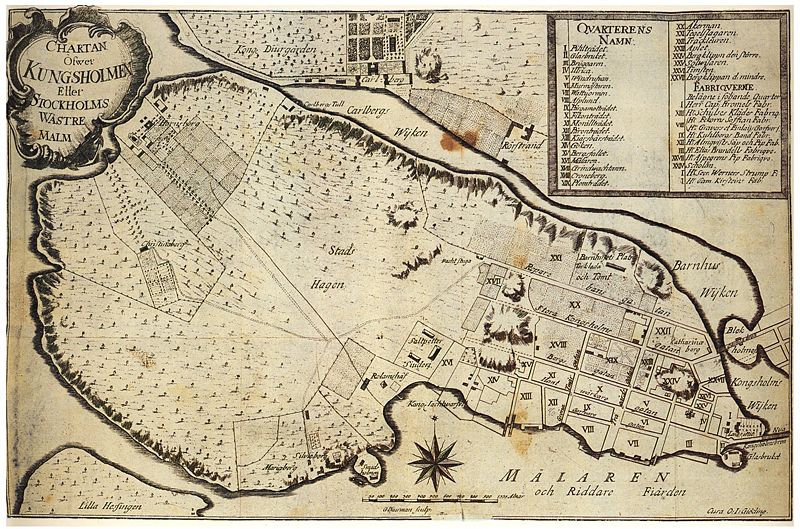
Kungsholmen 1754 - OJ Gjöding
Kungsholmen - an island in the city.
For most of the suburbs as you travel through, to and from the suburbs to the west. Or briefly visit in a matter of just returning. Finding new passport at the police station, make a cataract surgery at St. Erik, to celebrate weddings in City Hall, for a few selected a Nobel Dinner, for political buffs a debate in the City Council, for the criminal trial in the Town Hall, for sun-worshipers a bath at Smith Sudden, for exerciser are a passport with Friskis & Svettis Rålambshov, the genealogist a plunge in the town hall or the National Archives.
The city's childhood was this virgin hunting ground for the nobility and distinguished citizens.At the 1400 mid-century, it was summer home to Franciscan from the Franciscan monastery at Riddarholmen. They laid out gardens in the fertile valleys, built the brick out to the west and is said to have engaged in prohibited worldly pleasures.
Long way off the island was called Monk camp. One block at Hantverkargatan bears that name. Despite its relative youth, Kungsholmen, a rich and varied history and many of the activities carried out here has been significant development in the country.
The monks were expelled by King Gustav Vasa reduction - "they went out, taking something else before," wrote one chronicler. The land was taken over by the Crown but the island remained empty and deserted for more than a hundred years.
In the 1640s, donated the island to the city, a city plan was drawn up, Hantverkargatan got its name and glassblowers, klockgjutare, strumpstickerskor and tanners moved in, attracted by tax breaks and free from coercion guild.
Nobles and high officials built summer fun and let build beautiful gardens, Charles XI graciously gave permission to change the name Munk camp on Kungsholmen, a church was built and named after his wife Ulrika Eleonora.
In a few centuries Kungsholmen something of a pastoral idyll if you could Treaties smell of tanneries at Mälardalen beach, but then came the industrial explosion of Bolinders workshops, Separator, Eldkvarn, Samuel Owens steamboat yards. Ore Farms torn down, gardens disappeared and were replaced by factories and hospitals.Housing was built to work the invasion, but the dwellings were small, chiefly in one room and kitchen. So it is today.
From the rest of the city looked Kungsholmen hardly inviting, with a wall of workshop and factory chimneys against Clear Lake. It was dirty, ugly and poor. Starvation Holmen was called in the vernacular.
But there was a change. When Ragnar Östberg's stately City Hall stood on Eldkvarns place. When Sven Wallander functionalist building replaced the slums at the Royal Cliff. When Stockholm's most beautiful promenade built along Norrmälarstrand.
The Sports Palace taught thousands of Stockholm children to swim with the masterful swimmer Arne Borg watching from the pool side. To the biotäta St. Eriksgatan pilgrimages South residents over the North Bridge and the Dragon's fiance armchairs hugged young couples. They managed to maybe get an apartment in sunny Fredhäll, where there was both chutes and tub. Staying at Kungsholmen suddenly felt fresh and modern. In Marieberg rose the large newspaper houses. High above the Cape Smith lived Tage Erlander and Norrmälarstrand Sickan Carlsson.
Kungsholmen is currently about 50 000 inhabitants. They are much younger than the average in the rest of the city. Their average income is higher. There are 50 000 jobs within the district. 50 000 passengers passed through the subway latches Fridhemsplan every day.
And the future seems bright. Shops and bistros thrive. New construction projects are planned in the west. There is a spirit of optimism.
Forget starvation Holmen! Welcome to Kungsholmen!
"Poor Way. Fleming Way. Dusty with soot, grim and
mushy. With Grubbens tottering pauper and carpet whipping
insane, with trasklädda kids who played in the mud.
Poor street, lined with timber yards, stock barns and garages
where the factory pipes howled mornings and evenings. "So writes Per
Anders Fogelström in the novel "Mothers and sons." And the Swedish
Tourist Association's guidebook, this almost officiösa writing,
reported in 1929: "Fleminggatan offer, however, not
a casual browser to the eye. It is a broad, straight
street traffic, monotonous and joyless built on, and it has
not entirely without reason called for Stockholm's ugliest
street. " Naima Wifstrand does, however, proudly entitled "Naima
from Fleming Way "over the first chapter of his memoirs. In
ancient times it has been called Reparebansgatan, Glasbruksgatan
and Brickyard Road for companies that stood here. Grubbens
was in the 1840's a beautiful garden that stretched down
to Barnhus Bay. On summer evenings were treated to
entertainment in Grubbens Park. In 1860 took over the site of
the city, which opened a supply facility. It was replaced
in 1922 by St. Erik's Hospital. The largest house on the street is the
Trygg-Hansa's high-rise buildings in brick and concrete, built 1967-76
, designed by Anders Tengbom.
mushy. With Grubbens tottering pauper and carpet whipping
insane, with trasklädda kids who played in the mud.
Poor street, lined with timber yards, stock barns and garages
where the factory pipes howled mornings and evenings. "So writes Per
Anders Fogelström in the novel "Mothers and sons." And the Swedish
Tourist Association's guidebook, this almost officiösa writing,
reported in 1929: "Fleminggatan offer, however, not
a casual browser to the eye. It is a broad, straight
street traffic, monotonous and joyless built on, and it has
not entirely without reason called for Stockholm's ugliest
street. " Naima Wifstrand does, however, proudly entitled "Naima
from Fleming Way "over the first chapter of his memoirs. In
ancient times it has been called Reparebansgatan, Glasbruksgatan
and Brickyard Road for companies that stood here. Grubbens
was in the 1840's a beautiful garden that stretched down
to Barnhus Bay. On summer evenings were treated to
entertainment in Grubbens Park. In 1860 took over the site of
the city, which opened a supply facility. It was replaced
in 1922 by St. Erik's Hospital. The largest house on the street is the
Trygg-Hansa's high-rise buildings in brick and concrete, built 1967-76
, designed by Anders Tengbom.

Fleminggatan 1868 is a rural road in this
oil painting by CP Hallberg from the neighborhood of Crown Mountain. A
woman has been at the well and watering. In the background
is visible the city, including Klara church tower. The house that stands up
right on the horizon is the castle. (Stockholm City Museum).
Along the supply facility Grubbens with their servant was
poor relief boarder agency, where orphans and children
of destitute mothers received to be forwarded to the
home in the provinces. The aspiring writer Ivan Oljelund and
his brother got there and thought it was like heaven
compared to the asylum at Tjärhovsgatan. Photo about 1900.
(Stockholm City Museum).
FLEMING STREET
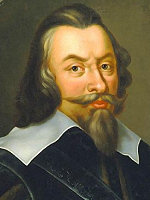 With good reason did Klas Fleming name to the street in 1885. He was Stockholm's first of the governor, a powerful and very energetic man. The decade of 1634-44, when he led the city became one of the most dynamic periods in the history of Stockholm. Munk camp (Kungsholmen) had belonged to the royal family and called "Queen's Island" after King Gustav II Adolf's widow Maria Eleonora. Then she fled from Sweden in 1640 began
With good reason did Klas Fleming name to the street in 1885. He was Stockholm's first of the governor, a powerful and very energetic man. The decade of 1634-44, when he led the city became one of the most dynamic periods in the history of Stockholm. Munk camp (Kungsholmen) had belonged to the royal family and called "Queen's Island" after King Gustav II Adolf's widow Maria Eleonora. Then she fled from Sweden in 1640 beganFleming apply pressure to the ground should be submitted to the city, which had room for "nyttige and good hantverksmän", especially for those who depended on access to water. An initial donation letter was issued in 1644 and Queen Christina of 1647 came to pass even the western part of Monk camp. For the city as a whole, however, Fleming's most remembered for his development plan (designed by
city engineer Anders Torstensson), which is the most comprehensive ever undertaken in Stockholm. On Norrmalm was torn down and moved over 2000 yards and straight streets mapped out. The plan was for the lower part of the Monk camp, which was still sparsely populated, applies broadly still. On the south where the problems bigger, but some plot owners managed to make beneficial changes. Technical Board House, where similar issues are dealt with today, was built 1962-65 by Nils Sterner and Carl-Olof Deurell as architects.
Over Governor Klas Fleming, who stood behind Stockholm's
first town plan was to give his name to Fleming Way. To
gain further glory and went out to war, but was hit
by a cannonball during the Battle of Femern in 1644. (National
portrait collections at Gripsholm).
In 1929 coverage was Hantverkargatan and the Royal Academy. The coin's Web site
was moved a bit into the left. Samuel Owens house
behind it was demolished. Photography from the 1910s. (Stockholm
City Museum).
behind it was demolished. Photography from the 1910s. (Stockholm
City Museum).

Hantverkargatan east. Photo: Peter Gullers
Carthage hill in Hantverkargatan had its name from an inn in the 1700s.The horse tram was a problem. Not even two horses could pull the dent young truck unless you have to resort to using horses.Help The driver, a beautifully uniformed young man, admired by the Kungsholmen small boys. The artist Gustav Magnusson says in the book "Outskirts Guy ':
"We saw the tram is approaching at a brisk trot. In its place -
just like a circus performer - was the enviable help the driver with reins and whip in one hand. In the other hand he held the big hook that was attached to the horse dragkejda. When the tram at full speed came up beside him he stepped easily and elegantly up on the step, bent down and attached the hook in the loop later in the tram, cracked the long whip - and up the hill we went with the horse on the sidelines and a piece in front of the two parhästarna. "Kungsholms line was the longest route was with horses. On February 10, 1905 was the last horse drawn tour from Tegelbacken with Drott and Vivi their harnesses, the first of eight carriages. There were more Tramway Board previously had eaten lunch at Rosenbad. Along Hantverkargatan had the Kungsholmen residents and cheered and waved.
"We saw the tram is approaching at a brisk trot. In its place -
just like a circus performer - was the enviable help the driver with reins and whip in one hand. In the other hand he held the big hook that was attached to the horse dragkejda. When the tram at full speed came up beside him he stepped easily and elegantly up on the step, bent down and attached the hook in the loop later in the tram, cracked the long whip - and up the hill we went with the horse on the sidelines and a piece in front of the two parhästarna. "Kungsholms line was the longest route was with horses. On February 10, 1905 was the last horse drawn tour from Tegelbacken with Drott and Vivi their harnesses, the first of eight carriages. There were more Tramway Board previously had eaten lunch at Rosenbad. Along Hantverkargatan had the Kungsholmen residents and cheered and waved.
Hornsberg
Reuben and Paul Ljungberg, a few optimistic brothers in the
construction business, founded in 1923, a velodrome in Hornsberg with
the Danish Ordrupbanan as a model. In Denmark, there was
betting and the brothers sought to keep the
totalizator. Authorities said no and therefore the project was
practically doomed. Husqvarna, which manufactured both
bicycles and motorcycles, supported them, but some
sponsorship efforts of the latter-day format will probably not have been.
company's name was painted in the concrete path and some of the
cyclists who appeared to belong to their "team". They competed
Friday evenings and Sundays during the warm season. Among
the more successful cyclists Artur brothers, Erik
and Hjalmar Bjurberg from Ulriksdal. Coffee and beer class
II was provided by Rudolf Norgren, the renowned
Journal of Education carrier from Stureplan. The popular, festive
'Danish' mood did not appear. Display
of the so-called flyer rides where the rider drives the wind craving for a
motorcycle, pulled some audiences, like boxing pro Harry Persson , when in 1927 he met the Americanheavyweight Bud Gorman, whom he defeated in the fifth round, then Gorman suffered broken bones.Ernst Rolf was the emcee. In 1931 it was demolished Velodrome and the city built the Kristineberg sports. From the air Velodrome was a truly magnificent facility. picture was taken facing west. Velodrome in Hornsberg never became a success, but riders who appeared there had fun. One of them was Gosta Törnqvist, as in more mature years were devoted to distribute newspapers from Klara.
JOHN ERICSSON THE STREET
Reuben and Paul Ljungberg, a few optimistic brothers in the
construction business, founded in 1923, a velodrome in Hornsberg with
the Danish Ordrupbanan as a model. In Denmark, there was
betting and the brothers sought to keep the
totalizator. Authorities said no and therefore the project was
practically doomed. Husqvarna, which manufactured both
bicycles and motorcycles, supported them, but some
sponsorship efforts of the latter-day format will probably not have been.
company's name was painted in the concrete path and some of the
cyclists who appeared to belong to their "team". They competed
Friday evenings and Sundays during the warm season. Among
the more successful cyclists Artur brothers, Erik
and Hjalmar Bjurberg from Ulriksdal. Coffee and beer class
II was provided by Rudolf Norgren, the renowned
Journal of Education carrier from Stureplan. The popular, festive
'Danish' mood did not appear. Display
of the so-called flyer rides where the rider drives the wind craving for a
motorcycle, pulled some audiences, like boxing pro Harry Persson , when in 1927 he met the Americanheavyweight Bud Gorman, whom he defeated in the fifth round, then Gorman suffered broken bones.Ernst Rolf was the emcee. In 1931 it was demolished Velodrome and the city built the Kristineberg sports. From the air Velodrome was a truly magnificent facility. picture was taken facing west. Velodrome in Hornsberg never became a success, but riders who appeared there had fun. One of them was Gosta Törnqvist, as in more mature years were devoted to distribute newspapers from Klara.
JOHN ERICSSON THE STREET
New radical ideas born in functionalism track on
1930's. Housekeeping and child care was considered
unfashionable. The modern woman would be given the opportunity for
recreation, club activities, fellowship and advancement. An increasing number of
gainfully employed, many mothers were single. Thus arose
the idea of collective living. One of those who marched at the head
was Alva Myrdal and she brought such architect Sven Markelius . Reultatet became family public house on the John Ericsson SE 6, which was finished in 1935th The apartments were small, the smallest just 15 square meters, but there were chutes, tvättnedkast and DUMBWAITER, where you could get food from the restaurant and return the disk. The children sent to day care, which at first were open around the clock, around the house, there were staff who helped with the laundry and cleaning. The project, which had been treated with a certain derision and derided as "Russian", received the most positive comments when the house was ready. The sloping balcony, which gave all the apartments to the street södersol andlake views, brought special admiration. "Markeliushuset" underwent a thorough renovation 1989-91 and has been declared as a monument.
1930's. Housekeeping and child care was considered
unfashionable. The modern woman would be given the opportunity for
recreation, club activities, fellowship and advancement. An increasing number of
gainfully employed, many mothers were single. Thus arose
the idea of collective living. One of those who marched at the head
was Alva Myrdal and she brought such architect Sven Markelius . Reultatet became family public house on the John Ericsson SE 6, which was finished in 1935th The apartments were small, the smallest just 15 square meters, but there were chutes, tvättnedkast and DUMBWAITER, where you could get food from the restaurant and return the disk. The children sent to day care, which at first were open around the clock, around the house, there were staff who helped with the laundry and cleaning. The project, which had been treated with a certain derision and derided as "Russian", received the most positive comments when the house was ready. The sloping balcony, which gave all the apartments to the street södersol andlake views, brought special admiration. "Markeliushuset" underwent a thorough renovation 1989-91 and has been declared as a monument.

Public House at John Ericsson Street attracted much
attention. The bold facade of the protected, rockrose
balconies, was admired, but some of the interior
facilities such tvättnedkast and DUMBWAITER thought
some were a little ridiculous. (Swedish Design).
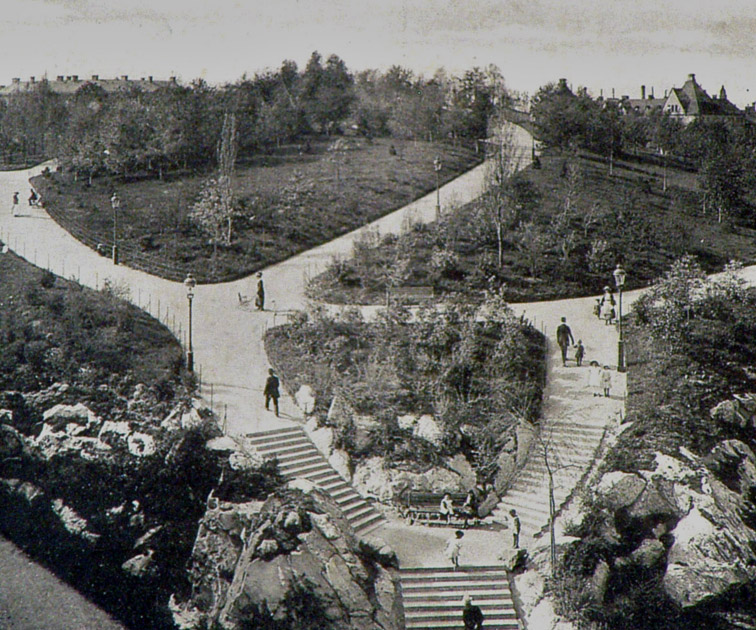
Kronoberg park at the beginning of the 1900s
"Be the capital's rock arranged to parks, needs
Stockholm successor, not so much to worry about costly and
time-consuming trips to the country, and he gets up, what hour
of the day it pleases him, in the nearest park, where it has
the opportunity to enjoy a rural nature to the fullest dimensions. "So
it was said in 1866 urban plan proposal. Before the turn of the century
was the work completed or underway in over a dozen
parks. One of them was Kronoberg Park. Here was formerly only
a few small shacks on the almost bare rock. In the northwest
corner was a little jew cemetery built in the 1780s.
Per Wästberg writes about it in "Half the Kingdom": "The gray
stones are small and thin, they look like a collection of heads of
toy house that has burned. "Before the park yet was fully
offered Crown Hill Kungsholmens best toboggan runs.
Heaven Hill from the top of the mountain down to Kronobergsgatan,
Kobacken, Bumps hill, swing jaw, Ekbacken. Stockholm's
longest ropewalk, from Scheelegatan, along
Kungsholmsgatan, until the park was demolished in 1904 to make way
for the police department. Children's Hospital, "Crown Princess Lovisa,"
erected at Polhemsgatan 1899, was demolished to make way for the
Police House extension in the early 1970's.
Stockholm successor, not so much to worry about costly and
time-consuming trips to the country, and he gets up, what hour
of the day it pleases him, in the nearest park, where it has
the opportunity to enjoy a rural nature to the fullest dimensions. "So
it was said in 1866 urban plan proposal. Before the turn of the century
was the work completed or underway in over a dozen
parks. One of them was Kronoberg Park. Here was formerly only
a few small shacks on the almost bare rock. In the northwest
corner was a little jew cemetery built in the 1780s.
Per Wästberg writes about it in "Half the Kingdom": "The gray
stones are small and thin, they look like a collection of heads of
toy house that has burned. "Before the park yet was fully
offered Crown Hill Kungsholmens best toboggan runs.
Heaven Hill from the top of the mountain down to Kronobergsgatan,
Kobacken, Bumps hill, swing jaw, Ekbacken. Stockholm's
longest ropewalk, from Scheelegatan, along
Kungsholmsgatan, until the park was demolished in 1904 to make way
for the police department. Children's Hospital, "Crown Princess Lovisa,"
erected at Polhemsgatan 1899, was demolished to make way for the
Police House extension in the early 1970's.
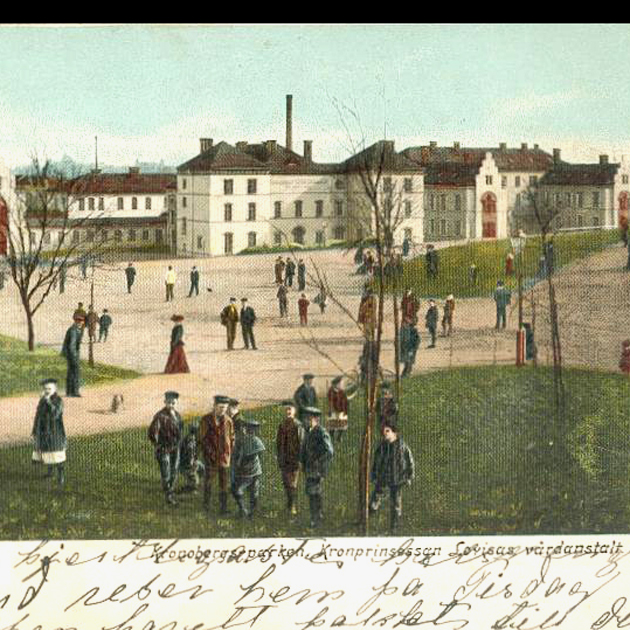
Crown Princess Lovisa Hospital at the beginning of the 1900s
In the early 1890s began Kronoberg park built.
Like the other new parks became immediately very popular
with locals. Summertime and the holiday was something that
existed only for the most wealthy. This is offered in
concert from the bandstand in the 1910s. Photo: Axel
Malmström. (Stockholm City Museum).
Like the other new parks became immediately very popular
with locals. Summertime and the holiday was something that
existed only for the most wealthy. This is offered in
concert from the bandstand in the 1910s. Photo: Axel
Malmström. (Stockholm City Museum).
Rålambshovsparken
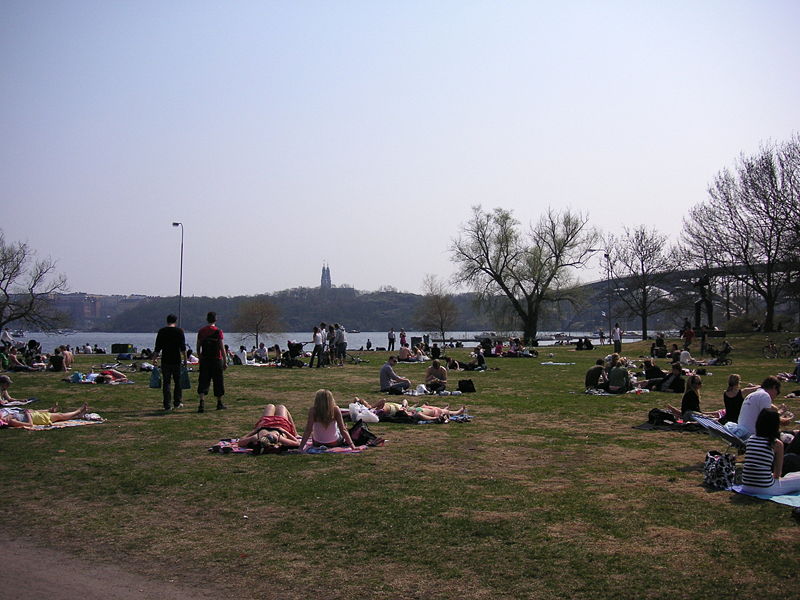
Rålambshovsparken - Photo: Holger Ellgaard
"Did you now Marieberg, / To see more Dutch,
with a yellow and faded paint / Himself a tent spreads.
windows sparkle. Do you know / Not Salpetersjuderi?
Once, Ulla - raillery! - / Gap where you lead. "
These words of warning addressed to the Bellman hound dog in
Fredman's Epistles n: o 48, during rowing past Rålambshov on
my way home from Essingen. Salpetersjuderiet was a terrible
place. There, working women from the Spinning House of mixing
rotten meat, feces, urine, lime and ground into a seething
mass. The nitric thereof which were used in the
production of gunpowder. Sjuderiets manager was former
hovtandläkaren, china director at the outdoor, Johan
Eberhard Ehrenreich, whose interest was to make an
extra income. Alimentation was lousy, no clothes were
never disclosed to the prisoners. When Ehrenreich went to
Germany continued his step-son, chamber musician Lars Lalin,
to mismanage the business. Per Anders Fogelström has in
the novel "weavers 'children' described the terrible
conditions that existed. In a letter of complaint was reported that
prisoners eating gravel for lack of food. In the winter of 1771-72 passed away
half brightness. Only seven years later incorporated the letter. The
survivors were across the bay to Långholmen.
with a yellow and faded paint / Himself a tent spreads.
windows sparkle. Do you know / Not Salpetersjuderi?
Once, Ulla - raillery! - / Gap where you lead. "
These words of warning addressed to the Bellman hound dog in
Fredman's Epistles n: o 48, during rowing past Rålambshov on
my way home from Essingen. Salpetersjuderiet was a terrible
place. There, working women from the Spinning House of mixing
rotten meat, feces, urine, lime and ground into a seething
mass. The nitric thereof which were used in the
production of gunpowder. Sjuderiets manager was former
hovtandläkaren, china director at the outdoor, Johan
Eberhard Ehrenreich, whose interest was to make an
extra income. Alimentation was lousy, no clothes were
never disclosed to the prisoners. When Ehrenreich went to
Germany continued his step-son, chamber musician Lars Lalin,
to mismanage the business. Per Anders Fogelström has in
the novel "weavers 'children' described the terrible
conditions that existed. In a letter of complaint was reported that
prisoners eating gravel for lack of food. In the winter of 1771-72 passed away
half brightness. Only seven years later incorporated the letter. The
survivors were across the bay to Långholmen.
Rålambshovs suburban house was built in 1801 as a summer house for the
governor Pehr Evert Georgii. In the 1930s, lived
Stockholm's popular mayor Gunnar Fant there. Photo from
the early 1900s. (Stockholm City Museum).
governor Pehr Evert Georgii. In the 1930s, lived
Stockholm's popular mayor Gunnar Fant there. Photo from
the early 1900s. (Stockholm City Museum).
SPORTS PALACE

On October 20, 1934 inaugurated the Sports Palace. The cost of
construction impressed, 6.5 million, it was claimed. The swimming pool
attracted the Stockholm Pride. Sports Palace was one of the
largest indoor parks in Europe, with 50-meter pool and
barnbad. From the south came the school children here and swam for
their brands, the already legendary master swimmer Arne Borg
and Channel swimmer Sally Bauer walked along the edge of the pool and
controlled. In the house there was a café and restaurant with
banquet room and lake view, club-rooms, gymnasiums,
tennis courts, a concert hall and a cinema called Rivoli.
Over theater kopparbeslagna entrance doors was a relief of
Gunnar Torhamn. Sports Palace had been established on private
initiative by K. Faugust, who was also a builder. Architect
, Jean S. Adrian. Towards the end of the 50s was the end of
the sporting activities. The interior was converted into offices
and department stores, the cinema became a recording studio. Something of a
role model for the Sports Palace was the St. Erik's Palace on the other
side of the street which was built in 1907-10 for industrial use and
housing. Architectural firm Dorph & Höög had done
the drawings.
Sports Palace took over the bath current role as a swimming school for
children of Stockholm. With its 50-meter pool was also a
much sought after competition hall. The photograph is from the inauguration
1934th (Stockholm City Museum).
children of Stockholm. With its 50-meter pool was also a
much sought after competition hall. The photograph is from the inauguration
1934th (Stockholm City Museum).
St. ERIK STREET
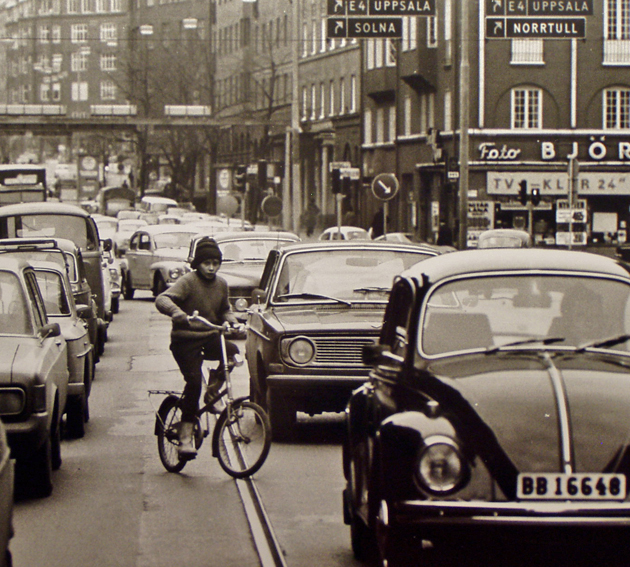
Young cyclist at St. Eriksgatan - Photo: Peter Gullers
Until the end of the 1800s was St. Eriksgatan a rural
road with small houses, surrounded by gardens. When the apartment buildings
were built at the turn retained parts of the gardens in
the form of planted courtyards. It gave a pleasing character
to the street, who was also sparsely trafficked before the bridge to
Vasastan was finished in 1906. When St. Eriksgatan was widened in
the 1930s, the courts of the sacrificed. The old road had
a few decades turned into a bustling
city street. The cinemas were more frequent here than anywhere
else on the island of Kungsholmen. First it was horse-Nisse , Stockholm
biokung, who in 1910 founded the St. Erik (Wolf / Spark) in the
current 35-ball. Then came in rapid succession Thule in the corner of
Alströmergatan and Thalia (Kronoberg-cinema) in No 28. Anders Sandrew opened its first cinema, the Metropol-Theater in the corner of Fleming Street in 1926, the same year came Strand in N ° 52. It was mostly action and bang-bang at St. Erik Street cinemas and post-West bridge origins wandering youngmatinee visitors right from Hornstull to see what was offered on the Caprice and the Alcazar, the Roxy and the Rivoli. Kungsholmens guys might possibly have been telling them about executioners Dalman,who had lived in 44-ball. His last mission fulfilled his 1910, when he beheaded the assassin Anderson by guillotine on Långholmen. It is the only time the guillotine was used in Sweden.
WEST BRIDGE
road with small houses, surrounded by gardens. When the apartment buildings
were built at the turn retained parts of the gardens in
the form of planted courtyards. It gave a pleasing character
to the street, who was also sparsely trafficked before the bridge to
Vasastan was finished in 1906. When St. Eriksgatan was widened in
the 1930s, the courts of the sacrificed. The old road had
a few decades turned into a bustling
city street. The cinemas were more frequent here than anywhere
else on the island of Kungsholmen. First it was horse-Nisse , Stockholm
biokung, who in 1910 founded the St. Erik (Wolf / Spark) in the
current 35-ball. Then came in rapid succession Thule in the corner of
Alströmergatan and Thalia (Kronoberg-cinema) in No 28. Anders Sandrew opened its first cinema, the Metropol-Theater in the corner of Fleming Street in 1926, the same year came Strand in N ° 52. It was mostly action and bang-bang at St. Erik Street cinemas and post-West bridge origins wandering youngmatinee visitors right from Hornstull to see what was offered on the Caprice and the Alcazar, the Roxy and the Rivoli. Kungsholmens guys might possibly have been telling them about executioners Dalman,who had lived in 44-ball. His last mission fulfilled his 1910, when he beheaded the assassin Anderson by guillotine on Långholmen. It is the only time the guillotine was used in Sweden.
WEST BRIDGE

West Bridge - Photo: Holger Ellgaard
Joseph Stewart grew up far north of Långholmsgatan.
Across the street were the barracks where the workers from Bergsunds
Mechanical Engineering lived. His playground was the South
, monograph Pålsundet, Långholmen. He felt this land
and the people who lived here. When the great bridge was built wrote
his one novel, which came to be counted among the great
works depictions. "People on a bridge" documents
an environment that was forever lost, when the West Bridge
was opened in a bleak November day 1935th Really does not match
his description of reality. The work records which he
cites is derived from Tranebergsbron, clear one years
earlier. West Bridge was the subject of an international
prize. Second prize winner, Ernst Gaber from Karlsruhe,
had called the proposal "Im Fels verspannt". Three meters
below the surface was a rock, where you could put one
of support. When the boss was on vacation sat two young
newly hired engineers to port administration
building department to process Gabers proposal. Their
alternative was accepted, and so built the bridge.
Managers consisted largely of Germans, the Swedes
had not yet sufficient expertise for such an advanced
project. But people from Ekensbergs Row co-
assembled. Bergsunds Mechanical did not participate in bridge construction
on their home turf. It had been closed 1929th
Across the street were the barracks where the workers from Bergsunds
Mechanical Engineering lived. His playground was the South
, monograph Pålsundet, Långholmen. He felt this land
and the people who lived here. When the great bridge was built wrote
his one novel, which came to be counted among the great
works depictions. "People on a bridge" documents
an environment that was forever lost, when the West Bridge
was opened in a bleak November day 1935th Really does not match
his description of reality. The work records which he
cites is derived from Tranebergsbron, clear one years
earlier. West Bridge was the subject of an international
prize. Second prize winner, Ernst Gaber from Karlsruhe,
had called the proposal "Im Fels verspannt". Three meters
below the surface was a rock, where you could put one
of support. When the boss was on vacation sat two young
newly hired engineers to port administration
building department to process Gabers proposal. Their
alternative was accepted, and so built the bridge.
Managers consisted largely of Germans, the Swedes
had not yet sufficient expertise for such an advanced
project. But people from Ekensbergs Row co-
assembled. Bergsunds Mechanical did not participate in bridge construction
on their home turf. It had been closed 1929th

West Bridge inauguration was a great event for locals, who were proud of the growing traffic, which
showed that Stockholm was becoming a big city. But the inhabitants of Långholmsgatan was not so excited about the
thundering articulated lorries and the clattering No. 4. Somewhere on the mountain I stand, eleven years old. Photo: Stockholm newspaper. (Stockholm City Museum).
showed that Stockholm was becoming a big city. But the inhabitants of Långholmsgatan was not so excited about the
thundering articulated lorries and the clattering No. 4. Somewhere on the mountain I stand, eleven years old. Photo: Stockholm newspaper. (Stockholm City Museum).
City Hall
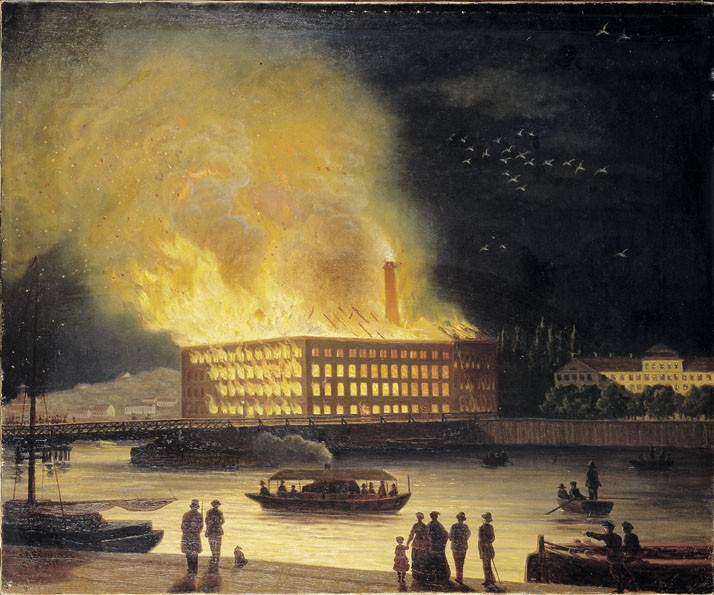
Eldkvarn burns October 31, 1878 - Painting of Giustaf Carleman
"When Eldkvarn burned" is a term for over a century
been used by locals as a time stamp. Over the years
it has become increasingly blurred. It was 31 October 1878th
No other fire in Stockholm has been more talked about and
yet it is far from being the largest. Eldkvarn got its name
from the time it was built in the early 1800s, it was the
first Swedish mill that was powered by steam engine - "fire and
air machine. " It was where City Hall now stands. From
åskådarsynpunkt situation was thus the very best. People
gathered on the quays and bridges, to Mary Hill and in
Skinnarviken. The clouds were low, it was hazy in the air, the
glowing powder dust sprayed out like eldfontäner and the flames
were reflected in the waters of Riddarfjärden. John fire department,
as this was his first major task was not much
to do to save the mill. After the fighting went on for
nearly three weeks. The entire Stockholm smelled of
smoldering grain. The mill was rebuilt and was in use
until 1902, when it was purchased by the city, who here plans to
build a city hall. The competition launched won by Ragnar
Östberg, but the municipality was going on, you wanted instead to have
a town hall in the grounds. Ostberg made new drawings, and in
1911 it was decided the building.
Eldkvarn, who was at the City Hall site, was rebuilt
after the fire 1878th The photograph is from the 1890s. Klara
and Kungsholmen have crept closer together. Kungsholms Bridge
was once over 500 meters long, one of the longest in Europe.
Photo: Oscar Ellquist. (Stockholm City Museum).
been used by locals as a time stamp. Over the years
it has become increasingly blurred. It was 31 October 1878th
No other fire in Stockholm has been more talked about and
yet it is far from being the largest. Eldkvarn got its name
from the time it was built in the early 1800s, it was the
first Swedish mill that was powered by steam engine - "fire and
air machine. " It was where City Hall now stands. From
åskådarsynpunkt situation was thus the very best. People
gathered on the quays and bridges, to Mary Hill and in
Skinnarviken. The clouds were low, it was hazy in the air, the
glowing powder dust sprayed out like eldfontäner and the flames
were reflected in the waters of Riddarfjärden. John fire department,
as this was his first major task was not much
to do to save the mill. After the fighting went on for
nearly three weeks. The entire Stockholm smelled of
smoldering grain. The mill was rebuilt and was in use
until 1902, when it was purchased by the city, who here plans to
build a city hall. The competition launched won by Ragnar
Östberg, but the municipality was going on, you wanted instead to have
a town hall in the grounds. Ostberg made new drawings, and in
1911 it was decided the building.
Eldkvarn, who was at the City Hall site, was rebuilt
after the fire 1878th The photograph is from the 1890s. Klara
and Kungsholmen have crept closer together. Kungsholms Bridge
was once over 500 meters long, one of the longest in Europe.
Photo: Oscar Ellquist. (Stockholm City Museum).
GARDEN CITY HALL

City Hall terrace - Oil on panel by Emil Hellbom
"Seeing the City Hall was like hearing the entire Swedish
cultural history talk in my sleep, "wrote commentator Stockholm
Kurt Bergengren, as ironic of all these relics
grouting or reconstructed. But he added: "To the
Swedish tradition of this building preserves hear ... the
honorable craft accomplishment of bricklaying and
carpentry. " The shape of the bricks was copied with great
skill for bargains in the Tre Kronor. Much of the
old have gathered in City Hall Garden. To the west are
limestone wall from Wallenberg's house at the Royal Garden.
family contributed money to the City Hall construction. For there
is a wall well as from the first
water plant in the South. Far to the west, the tower's
base, is Birger Jarl's pretend grave - the original preserved in
Varnhem Abbey - and a granite stock, meaning the
stock, which according to legend, ran ashore on Riddarholmen and
led to the founding of Stockholm. Quite true, however,
a vault from Palmstedt graceful Riddarholmsbro, which is
built into the so-called Birger Skansen's eastern wall. The shore
, the water smooth rocks, to give the illusion that
City Hall is built on solid foundations. But the connoisseur can see that
ice ridges in the wrong direction. On Midsummer Day
1923, 400 years after King Gustav Vasa's entrance, opened in City Hall.
City Hall Garden offers a magnificent view of Gamla Stan
and Södermalm, but it is also an attraction in itself with
many references to the history of Stockholm. Photography Frani
1924th (Stockholm City Museum).
cultural history talk in my sleep, "wrote commentator Stockholm
Kurt Bergengren, as ironic of all these relics
grouting or reconstructed. But he added: "To the
Swedish tradition of this building preserves hear ... the
honorable craft accomplishment of bricklaying and
carpentry. " The shape of the bricks was copied with great
skill for bargains in the Tre Kronor. Much of the
old have gathered in City Hall Garden. To the west are
limestone wall from Wallenberg's house at the Royal Garden.
family contributed money to the City Hall construction. For there
is a wall well as from the first
water plant in the South. Far to the west, the tower's
base, is Birger Jarl's pretend grave - the original preserved in
Varnhem Abbey - and a granite stock, meaning the
stock, which according to legend, ran ashore on Riddarholmen and
led to the founding of Stockholm. Quite true, however,
a vault from Palmstedt graceful Riddarholmsbro, which is
built into the so-called Birger Skansen's eastern wall. The shore
, the water smooth rocks, to give the illusion that
City Hall is built on solid foundations. But the connoisseur can see that
ice ridges in the wrong direction. On Midsummer Day
1923, 400 years after King Gustav Vasa's entrance, opened in City Hall.
City Hall Garden offers a magnificent view of Gamla Stan
and Södermalm, but it is also an attraction in itself with
many references to the history of Stockholm. Photography Frani
1924th (Stockholm City Museum).
No comments:
Post a Comment
Leave your thoughts here